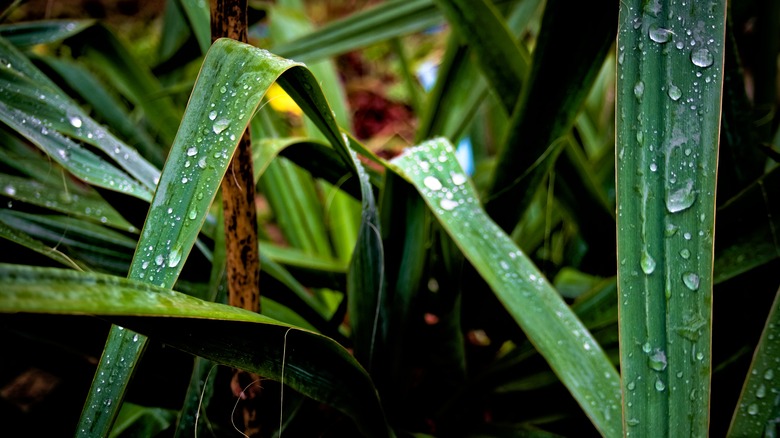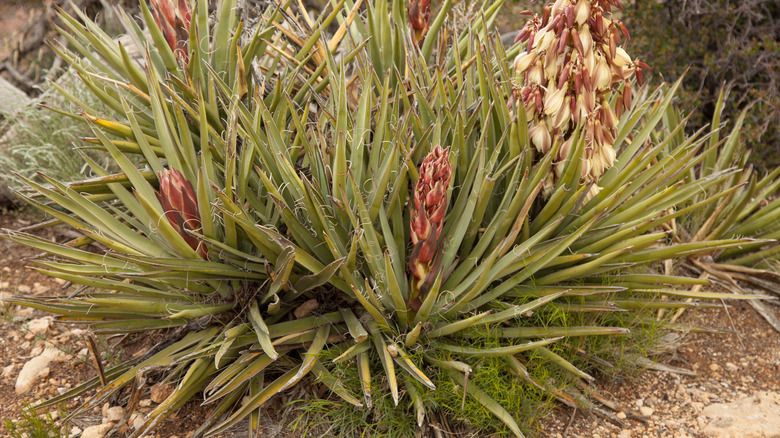Yucca plants, common in warmer climates, have made their way into many plant enthusiasts’ homes. Known for its sword-shaped leaves and striking white flowers, yucca typically thrives in arid environments. Resilient and adaptable, yuccas can endure diverse conditions, from deserts to grasslands. The plant’s architectural beauty extends to its blossoms — bell-shaped, clustered, and often fragrant. Yuccas prefer well-drained soil and plenty of sunlight, making regions like the southwestern United States, Mexico, and parts of Central America ideal for their growth. However, some species can also flourish in temperate climates or sunny living rooms with proper care, making them popular choices in gardens and homes alike. Nevertheless, they do require specific care, especially when growing outside their preferred climate. Most often, novice gardeners neglect their sunlight, watering, and soil needs.
One common mistake that gardeners can make is not providing adequate sunlight. Yucca plants thrive in abundant sunlight, preferably full sun exposure for at least six hours daily. They flourish in bright, direct sunlight, which promotes robust growth and encourages flowering. Insufficient light can manifest through various symptoms in yucca plants. Sparse or elongated growth with leaves stretching toward the light source indicates they’re reaching for more sun. Foliage might become pale or yellowish, and the plant may appear leggy. Reduced or lack of flowering, slow growth, or stunted development are further signs of inadequate light. Yuccas require ample sunlight to maintain their characteristic sturdy structure and vibrant green leaves, and to facilitate the energy necessary for healthy growth and flowering. Along with not providing the right light conditions, what other mistakes should you avoid?
Overwatering a yucca plant

Another common mistake that may be hindering the growth of your yucca plant is overwatering. This can lead to a cascade of issues that can detrimentally impact their health. Yuccas, adapted to arid conditions, are highly susceptible to root rot and other complications when exposed to excessive moisture. When overwatered, the soil becomes waterlogged, depriving the roots of oxygen and causing them to suffocate. This lack of oxygen impairs the root system’s ability to absorb nutrients and water efficiently, weakening the entire plant.
Symptoms of overwatering in yucca plants are easily identifiable. Yellowing or wilting leaves, especially at the base, are early indicators. As the condition persists, the leaves may turn brown and mushy, and the plant’s growth slows down significantly. Root rot becomes apparent, with a foul odor emanating from the soil and the roots appearing dark, soft, and unhealthy.
Proper watering practices are crucial for yucca plant care. Allow the soil to dry out partially between waterings, ensuring the top 2-3 inches of the soil are dry before rewatering. When watering, thoroughly saturate the soil but avoid excessive moisture buildup. Opt for a well-draining potting mix and ensure the container has drainage holes to prevent waterlogging. During winter or dormant periods, reduce watering frequency, as yuccas require less water during these periods. A watering schedule based on the plant’s environment, season, and soil moisture level is beneficial. Observe the plant’s response to watering and adjust the frequency based on its specific needs.
Soil issues for a yucca plant

Yet another issue for yucca plants is using improper soil, as the soil condition significantly impacts a yucca plant’s health. Improper soil composition can lead to various issues, particularly for a species that thrives in arid conditions. Yuccas demand well-draining soil to prevent water accumulation around their roots, avoiding conditions conducive to root rot and fungal diseases.
Symptoms of improper soil in yucca plants are evident. Yellowing or browning of leaves, especially at the base, indicates waterlogged soil. Wilting or drooping foliage, despite adequate watering, can signal root issues due to poor drainage. Stunted growth, with the plant failing to flourish or produce new growth, is another sign of unsuitable soil conditions. Yuccas prefer a sandy, well-draining soil mix. A combination of sandy soil, perlite, or coarse sand in the potting mix promotes adequate drainage. To test soil drainage, conduct a simple “percolation test.” Dig a hole, fill it with water, and observe how quickly it drains. If water stands for an extended period, the soil likely lacks proper drainage.
Amending improper soil conditions involves adjusting the soil mix. Repot the yucca in a container with well-draining soil, ensuring the pot has drainage holes. If planting in the ground, amend the soil by incorporating better drainage materials. Big Bend Yucca Company recommends, “If your soil is clay or doesn’t drain well, mix in small pebbles or sand to improve drainage.” Avoid rich or water-retentive soils, as they hinder yucca growth.



